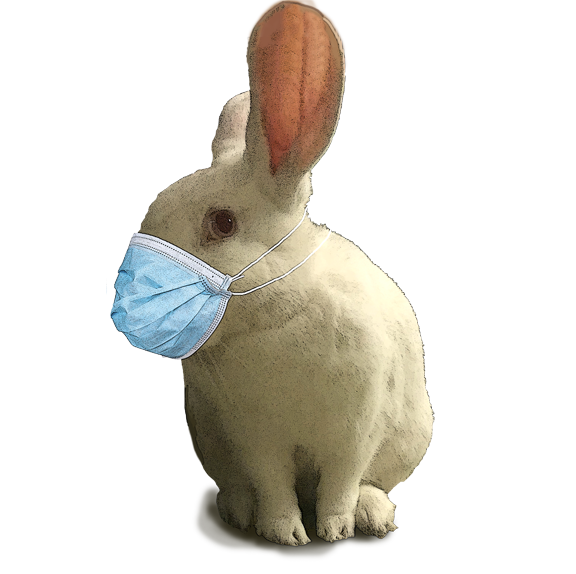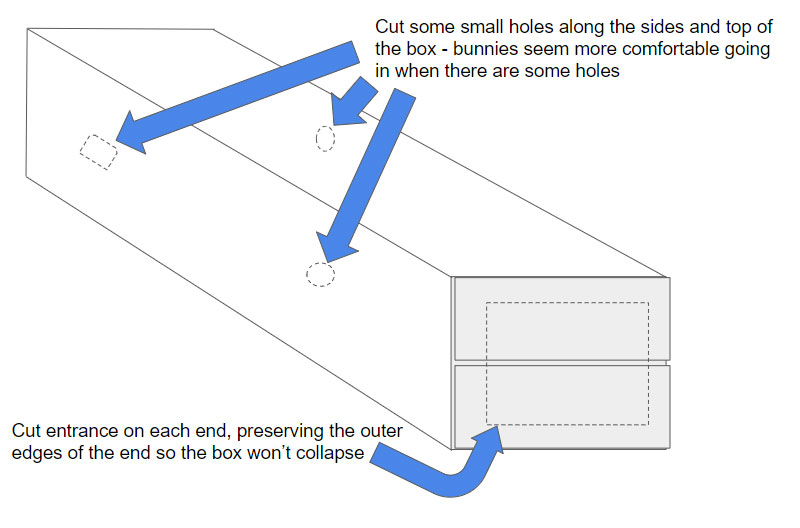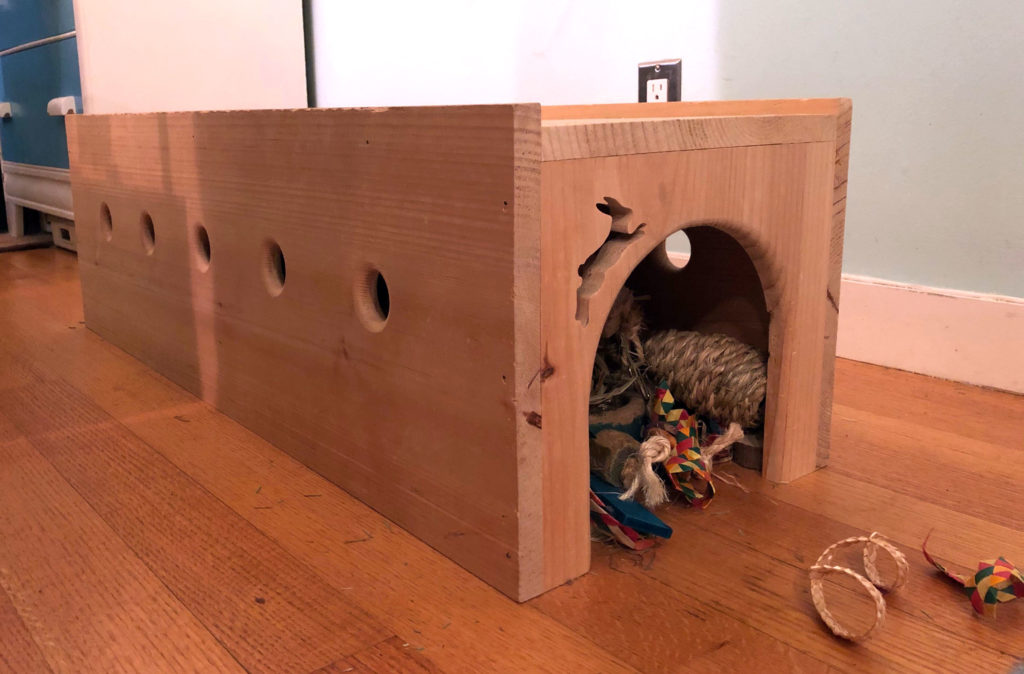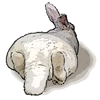
Things are weird – I think we can all agree on that. Make a silver lining for your rabbit.
Today I’ll share one rabbit enrichment tool that was born out of the circumstances of the pandemic. I’ll also show you how to easily create one for your rabbit.
What is Enrichment?
Even though they’re not adapted to live in the wild any more, pets still enjoy doing many things their wild ancestors did. Enrichment means providing ways for them to safely do those same things in a man-made environment. For rabbits, examples are chewing on stuff, digging, running around, grazing, and snuggling.
The Birth of the Tunnel
One evening in April I was staring at a pile of empty cardboard boxes that needed to be broken down for recycling. With the onset of shelter-in-place rules, my husband and I had begun to order more things online for shipping rather than going to stores. In San Francisco, you’re supposed to break cardboard down to two-by-two feet for recycling. This is a chore that neither of us exactly relish. We were each hoping the other was going to do the honors. The pile had grown into a human-size cardboard beaver dam in our living room.
But where there is cardboard there lies an opportunity for a rabbit toy! Cardboard is versatile enough to be bent or cut into lots of shapes. And for bunnies, chewing on it is like binge watching cable TV is for Americans: non-stop entertainment! Also, chewing helps rabbits wear down their teeth. Rabbit teeth, unlike ours, grow perpetually like fingernails.
So instead of breaking the boxes down, I put them together to form a tunnel for our buns to run through.
As I mentioned in a previous post, domesticated rabbits are descended from European rabbits who tunnel underground to create their communal living quarters. Activities like running through a tunnel, or digging, are species-specific (hard-wired) behaviors for domesticated rabbits. Many rabbits find a jaunt through a tunnel pleasurable and envigorating, the way a human might feel about a hike through the woods.
You may notice that if you have two large objects (e.g., pieces of furniture) next to each other in your home, with just enough space between them for a rabbit to squeeze through, your rabbit can’t resist creeping in there to check it out. What he sees is a tunnel. If the space ends in a wall, more likely than not that rabbit will start trying to dig the wall. He is trying to make the tunnel longer! To your rabbit these behaviors make total sense. He can’t imagine why anyone would act any other way, much less consider this behavior a threat to the recovery of their security deposit. Sooo…
Bunny-proofing tip:
- Don’t create those little gaps between things!
- Either separate them more, or
- push them flush against each other to prevent this behavior.
- If you can’t take either of those steps to prevent the digging, then put something at the end of the “tunnel” that is safe and satisfying to dig in, like a few layers of cardboard to cover the wall, preceded by a pile of towels or blankets. (Back in the day, I would have said a phone book.)
Also, if this happens, take a hint! A rabbit who is obsessed with these accidental tunnels is telling you what he wants for Christmas (or his birthday, or whatever excuse he can find for getting a present) — he wants a tunnel of his own! And if he’s digging as well, he wants stuff in the tunnel to dig. Providing your long-eared lad with his own, human-sanctioned tunnel will do more than make his dreams come true. It should also help divert him from tunneling in inappropriate places, thereby giving you something to celebrate, too.
How to Create your Own Rabbit Tunnel
There are a few different ways to create a great rabbit tunnel.
Multi-Box Methods
That first “COVID tunnel” was rigged up by taking a lot of different sized boxes and taping them to each other. You can put them in any configuration that creates a through-path for the rabbit. Our rabbits enjoyed that tunnel, but taping boxes together isn’t ideal. For one thing, rabbits might start chewing too much of the sticky tape. If that happens, I would get rid of the tunnel. (What’s wrong with eating sticky tape? Maybe nothing. I’m no vet. Just seems like the kind of thing that could gum up a sensitive bunny’s gut.) It can also be tricky to tape things securely enough to make a solid structure. Mine was a little rickety. Thus, it eventually did get broken down for recycling.
A few weeks later I tried again. We were getting weekly deliveries from a place that used the same size box every time. After a little experimentation I figured out that with a few simple, well-placed cuts I could create an interesting zig-zag tunnel from box to box that would hold itself together without tape. That tunnel is much more stable, and a big hit!
I’ll show you how to make a tapeless tunnel in the video below. If you don’t already have access to a bunch of boxes the same size you could try doing this with some that are similar in size, or you could check with a local store to see if they have a lot of cast-off boxes about the same size.
Notice that the boxes I used happen to have pre-cut holes in them. That’s also a plus. Some rabbits are reluctant to enter a tunnel that has no holes in it. I’m not sure why this is. Rather than speculate the possible causes, I’ll just say that if your boxes don’t have holes, and your bun is not going in, I recommend cutting a few holes to see if that helps.
The Single Long Box Method
An even easier method is to use one very long box for your tunnel. Obviously, this takes a special sort of box. It should be long and thin with ends that are just a little bigger than your rabbit. Although it’s a very simple, straight tunnel, your rabbit will still enjoy it. You can stuff it with safe digging materials such as plain packing paper and rabbit toys to add interest. A bunner who loves to dig will think she’s gone to rabbit heaven! The main thing to keep in mind when you create this version is that you want to preserve some of the end of the box when you cut it. That way your tunnel won’t collapse on your bunny like a poorly pitched pup tent. This diagram shows how I cut long boxes to make rabbit tunnels.

The Penthouse Tunnel
If you don’t want to make your own, you can also buy nice rabbit tunnels online. Many rabbit supply sites have pre-made cardboard ones. If you really want to splurge, I have seen some beautiful hand-crafted wooden tunnels on Etsy. For example, we bought this one a few years ago for a rabbit whose gut could not tolerate cardboard consumption.

Most rabbits really dig having a tunnel – in more ways than one! However you do it, I highly recommend you add one to your bun’s world. What’s great is that you don’t have to spend a lot of money or make a big effort to provide this very effective enrichment for your bunny.
 The Fluffy Tail of This Blog Post
The Fluffy Tail of This Blog Post
With or without a pandemic forcing you to stay at home, enrichment is key for keeping both rabbits and humans happy together. Making a tunnel to run and dig in is one of many things you can easily and cheaply do to enhance your rabbit’s world, while diverting her from destroying yours! What things have you been doing or creating for your rabbit’s enrichment? I’d love to hear your comments. We can all use more ideas!
P.S. you can get a poster of Finnegan with a COVID mask on Zazzle